Reptile & Amphibian
News Blog
Keep up with news and features of interest to the reptile and amphibian community on the kingsnake.com blog. We cover breaking stories from the mainstream and scientific media, user-submitted photos and videos, and feature articles and photos by Jeff Barringer, Richard Bartlett, and other herpetologists and herpetoculturists.
Thursday, September 13 2018
How awesome is this group of breeding Gharials in our Herp Photo of the day, uploaded by kingsnake.com user Lucky_7 . Be sure to tell them you liked it here!

Upload your own reptile and amphibian photos at gallery.kingsnake.com, and you could see them featured here!
Wednesday, September 12 2018
This is a once in a lifetime shot! How cool is this field shot of an Alameda whipsnake grabbing a meal in our herp photo of the day, uploaded by kingsnake.com user trevid ?! Be sure to tell them you liked it here!

Upload your own and photos at gallery.kingsnake.com, and you could see them featured here!
Tuesday, September 11 2018
If this axolotl in our Herp Photo of the day, uploaded by kingsnake.com user tadpoleo doesn't make you smile, I am not sure what will! Be sure to tell them you liked it here!

Upload your own reptile and amphibian photos photos at gallery.kingsnake.com, and you could see them featured here!
Monday, September 10 2018
What a cool field shot of this Collared Lizard (Crotaphytus reticulatus) in our Herp Photo of the day, uploaded by kingsnake.com user reptoman ! Be sure to tell them you liked it here!

Upload your own reptile and amphibian photos photos at gallery.kingsnake.com, and you could see them featured here!
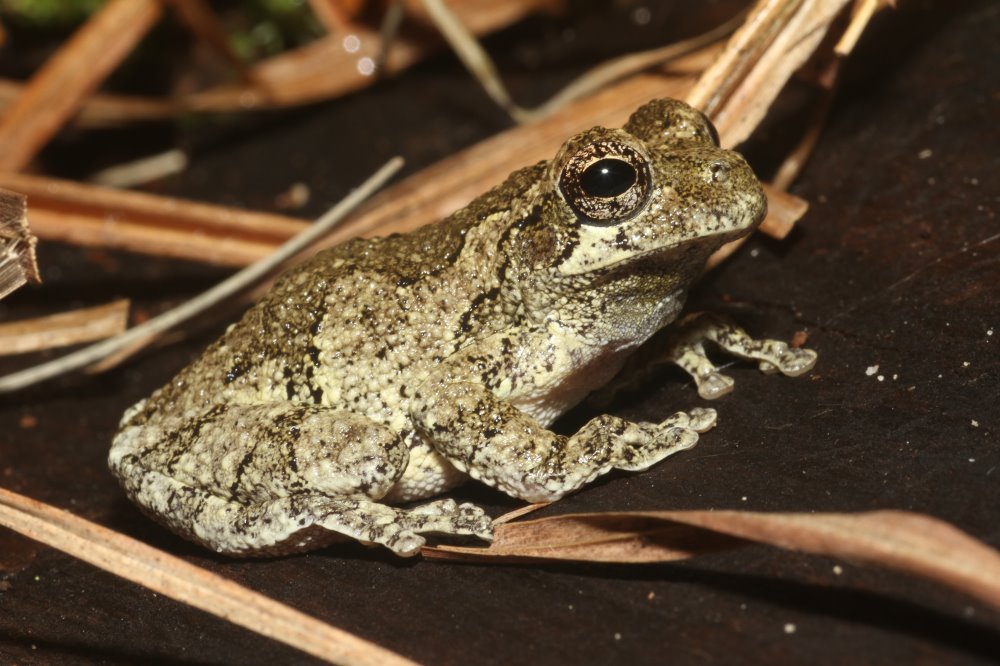
Once thought to be restricted to southernmore locales, Cope's gray treefrog is now known to occur pretty much over the entire range of the gray treefrogs. This is Hyla chrysoscelis.
Two genetic terms, diploid and tetraploid come into play when discussing these 2 lookalike species, the Gray treefrog, Hyla versicolor and Cope’s gray treefrog, Hyla chrysoscelis. At one time it was thought the the two could be identified by range and/or call with versicolor being the more northerly and having the more slowly trilled, more pleasing (=musical) call. These are now known to be invalid criteria. A friend has found versicolor as far south as Tallahassee, FL and others have found chrysoscelis as far north as Michigan and Massachusetts.
So, exactly how do you separate these 2 common treefrogs? Well, unless you have a genetics lab available you do so inexactly. With a lab, chromosome count can be determined. The gray treefrog is tetraploid, having twice the number of chromosomes as the diploid Cope’s gray treefrog. Without the lab you’ll have to extrapolate and hypothesize, determining the findings of previous researchers for the frogs from a given locale, then comparing whether the calls are pleasant and rather slowly trilled or harsh and rapidly pulsed (almost like a rivetgun)—and of course this latter will only work on the males—the females are silent. And I still find that gray treefrogs are the more common in the northerly climes while Cope’s gray treefrogs are more common in the south.
So you should now be able to at least guess at the identification of the treefrog you are listening to or watching. And of course the name, “gray”, is definitive, right. Nope. While they are often gray, they might actually be a pretty green through shades of gray to almost white. But in all phases they do have a white marking beneath each eye and extensive orange in the groin region.
Have fun.
Continue reading "The Gray Treefrogs"
Friday, September 7 2018
Do you know a diabetic? LLet them know that animals like this Gila Monster in our herp photo of the day in our Herp Photo of the day, uploaded by kingsnake.com user LJs Herps Are helping to save their lives! Medication made from the venom of Gila Monsters helps to keep blood sugar balanced for millions in the world. We celebrate all things venomous on Rattlesnake Friday to help remind people of the importance of the malaligned animals Be sure to tell them you liked it here!

Upload your own reptile and amphibian photos at gallery.kingsnake.com, and you could see them featured here!
Thursday, September 6 2018
What a stunning Mt. Horned Dragon in our Herp Photo of the day, uploaded by kingsnake.com user firereptiles ! Be sure to tell them you liked it here!

Upload your own reptile and amphibian photos photos at gallery.kingsnake.com, and you could see them featured here!
Wednesday, September 5 2018
Amazon Tree Boas are some of the most photogenic snakes in our world, like this one in our Herp Photo of the day, uploaded by kingsnake.com user BPruett , always perfectly posed! Be sure to tell them you liked it here!

Upload your own reptile and amphibian photos at gallery.kingsnake.com, and you could see them featured here!
Tuesday, September 4 2018
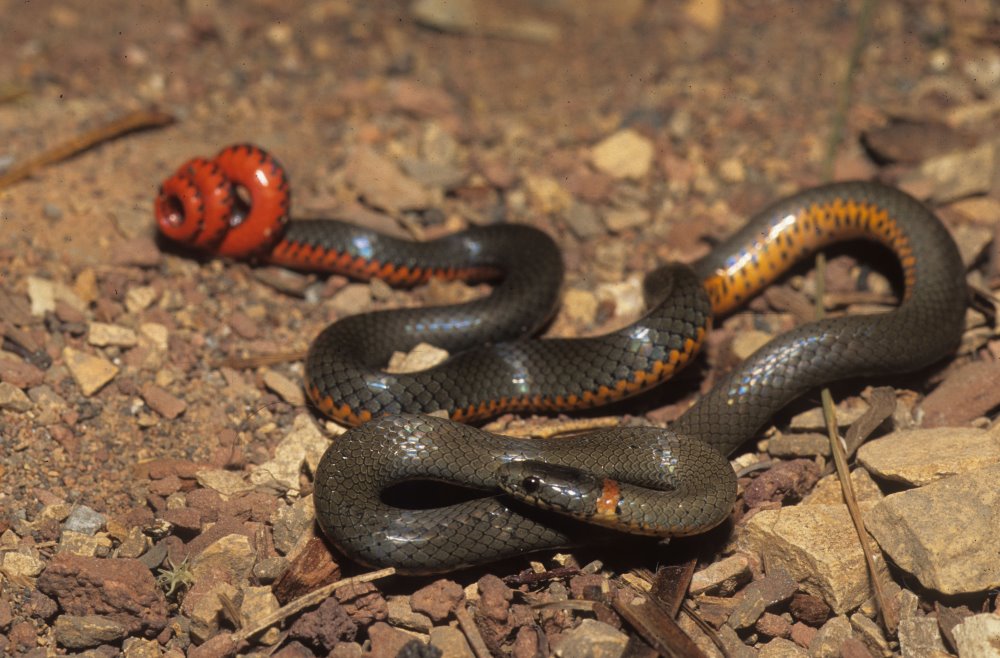
San Diego ringneck, D. p. similisAmazingly, even today, in the midst of nomenclatural clownery, there remain 12 subspecies of ring-necked snake, Diadophis punctatus, in the USA. When you add the 2 exclusively Mexican forms (Todos Santos ringneck, D. anthonyi and the Michoacan ringneck, D. dugesii) there are 14 subspecies.
But for now let’s stick with the USA forms. Of the 12, 1 is northeastern (plus adjacent Canada), 3 are southeastern, 2 are more or less centralian, and 6 occur along the Pacific Coast from southern CA (and nearby Baja) to central WA. Interestingly, although a couple extend beyond CA, all 6 of these subspecies may be found somewhere in CA. And among those 6 are some of the most resplendent subspecies (not that all ringnecks, no matter where they may be found, aren’t of noteworthy beauty).
Here is a listing of the USA ringnecks as well as pix of three of the most brightly colored Pacific Coast subspecies.
Northeastern ring-necked snakes:
D. p. edwardsii — northern ring-necked snake
Southeastern ring-necked snakes:
D. p. acricus — Key ring-necked snake
D. p. punctatus — southern ring-necked snake
D. p. stictogenys — Mississippi ring-necked snake
Centralian ring-necked snakes:
D. p. arnyi — prairie ring-necked snake
D. p. regalis — regal ring-necked snake
Pacific Coast ring-necked snakes:
D. p. amabilis — Pacific ring-necked snake
D. p. modestus — San Bernardino ring-necked snake
D. p. occidentalis — northwestern ring-necked snake
D. p. pulchellus — coralbelly ring-necked snake
D. p. similis — San Diego ring-necked snake
D. p. vandenburgii — Monterey ring-necked snake
Continue reading "West Coast Ringnecks"
This is dedicated to everyone who thinks Pythons are just fat lazy snakes. I present the glorious Savu Python ( Liasis mackloti savuensis) in our herp photo of the day, uploaded by kingsnake.com user chefdev ! Agile, active, light bodied and their color, you can only appreciate their beauty in person. Be sure to tell them you liked it here!

Upload your own and photos at gallery.kingsnake.com, and you could see them featured here!
Friday, August 31 2018
Happy Rattlesnake Friday! This big momma Timber rattlesnake shot in the field in our Herp Photo of the day, uploaded by kingsnake.com user throatoyster is a thing of beauty! Be sure to tell them you liked it here! As always on Friday, we celebrate all of our venomous reptiles for their contribution to the world.

Upload your own reptile and amphibian photos at gallery.kingsnake.com, and you could see them featured here!
Thursday, August 30 2018
There is no mistaking why these guys are called the yellow-belly puffing snake ( Spilotes sulphureus), as you can see in our herp photo of the day, uploaded by kingsnake.com user zmarchetti ! Be sure to tell them you liked it here!

Upload your own and photos at gallery.kingsnake.com, and you could see them featured here!
Wednesday, August 29 2018
This frillie looks a little angry our herp photo of the day, uploaded by kingsnake.com user nydon ! Be sure to tell them you liked it here!

Upload your own and photos at gallery.kingsnake.com, and you could see them featured here!
Tuesday, August 28 2018
What a chunker! I'm just gonna go out on a limb and say that the Barking Tree Frog in our herp photo of the day, uploaded by kingsnake.com user saltycity has never missed a meal! Be sure to tell them you liked it here!

Upload your own reptile and photos at gallery.kingsnake.com, and you could see them featured here!
Monday, August 27 2018
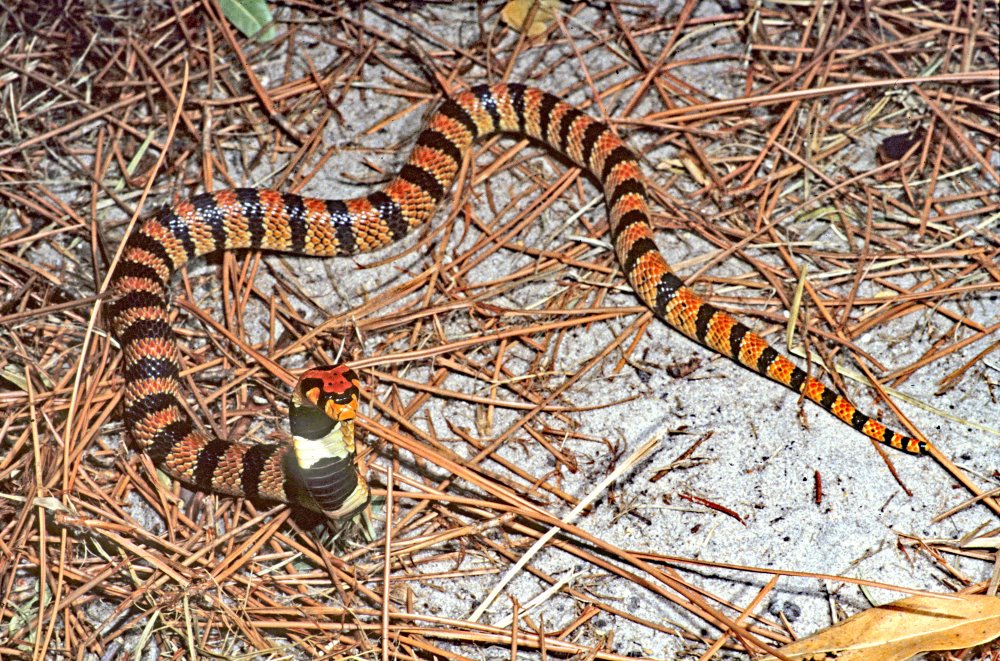
The hobbyist favorite, the colorful South African coral cobra.
Of the 3 subspecies of this interesting, 23 to 30 inch long, burrowing, elapine snake, it is the most brightly colored, southernmost, race, the Cape coral cobra, Aspidelaps l. lubricus, that is the hobbyist favorite.
A snake of arid habitats of the Cape region of South Africa and southern Namibia, when young this narrow-hooded cobra relative is clad dorsally and laterally in broad red and, except for the broad black nuchal marking, narrow black rings. When its anterior is elevated in the defensive posture, 2 or 3 broad black bands are displayed across its white throat and anterior venter. The red body rings are brightest dorsally and may fade noticeably on the sides. As the snake grows and ages the rings tend to break and become incomplete ventrally. The triangular nose-tip rostral scale is noticeably enlarged and helps this little snake with its burrowing proclivities. In nature it crepuscular and nocturnal and is often found beneath rocks.
The 2 more northerly forms, A. l. cowelsi of central Namibia and A. l. infuscatus (this latter being of questionable validity) of northern Namibia and southern Angola, are duller in color and may attain a slightly larger size. They are only marginally differentiated from each other, the former having a dark head and the latter having a light head, and are best identified by range.
Captives are easily maintained and, if cooled slightly in winter breed readily Frozen/thawed mice of suitable size are usually hungrily accepted as are various lizards. A clutch may contain from 4 to 8 (rarely a few more) eggs.
No matter how long they are captive, the coral cobras usually retain a feisty disposition, huffing, puffing, and occasionally striking at any and all disturbances.
Human deaths have been caused by bites from this small snake. The venom is neurotoxic. Extreme care should be used at all times.
Continue reading "The Coral Cobras, Cape, Namibian, and Angolan"
We totally LOVE this Cribo in our Herp Photo of the day, uploaded by kingsnake.com user steve fuller ! We are so jealous! Be sure to tell them you liked it here!

Upload your own reptile and amphibian photos photos at gallery.kingsnake.com, and you could see them featured here!
Friday, August 24 2018
Happy Rattlesnake Friday! This is a stunning shot of a Western Diamondback Rattlesnake in our Herp Photo of the day, uploaded by kingsnake.com user juzior ! Be sure to tell them you liked it here! As always on Friday, we celebrate all of our venomous reptiles for their contribution to the world, not just rattlesnakes. They all need our help to change misconceptions.

Upload your own reptile and amphibian photos at gallery.kingsnake.com, and you could see them featured here!
Thursday, August 23 2018
That's a whole lotta bull. Bullsnake that is! Loving the colors on the one here in our herp photo of the day, uploaded by kingsnake.com user orchidspider has never missed a meal! Be sure to tell them you liked it here!

Upload your own reptile and photos at gallery.kingsnake.com, and you could see them featured here!
Wednesday, August 22 2018
There might be a poem that matches this Sinaloan Milk Snake's colors in our Herp Photo of the day, uploaded by kingsnake.com user kingzilla but we promise that poem is not 100% correct! Be sure to tell them you liked it here!

Upload your own reptile and amphibian photos at gallery.kingsnake.com, and you could see them featured here!
Tuesday, August 21 2018
Ever wonder what a group of frogs would talk about? This batch of White's Tree Frogs seem like they are having a meeting of the minds in our herp photo of the day, uploaded by kingsnake.com user DanitaParapai ! Be sure to tell them you liked it here!

Upload your own and photos at gallery.kingsnake.com, and you could see them featured here!
Monday, August 20 2018
This little Dumeril's Boa is ready to rock in our Herp Photo of the day, uploaded by kingsnake.com user liljenni . Be sure to tell them you liked it here!

Upload your own reptile and amphibian photos at gallery.kingsnake.com, and you could see them featured here!
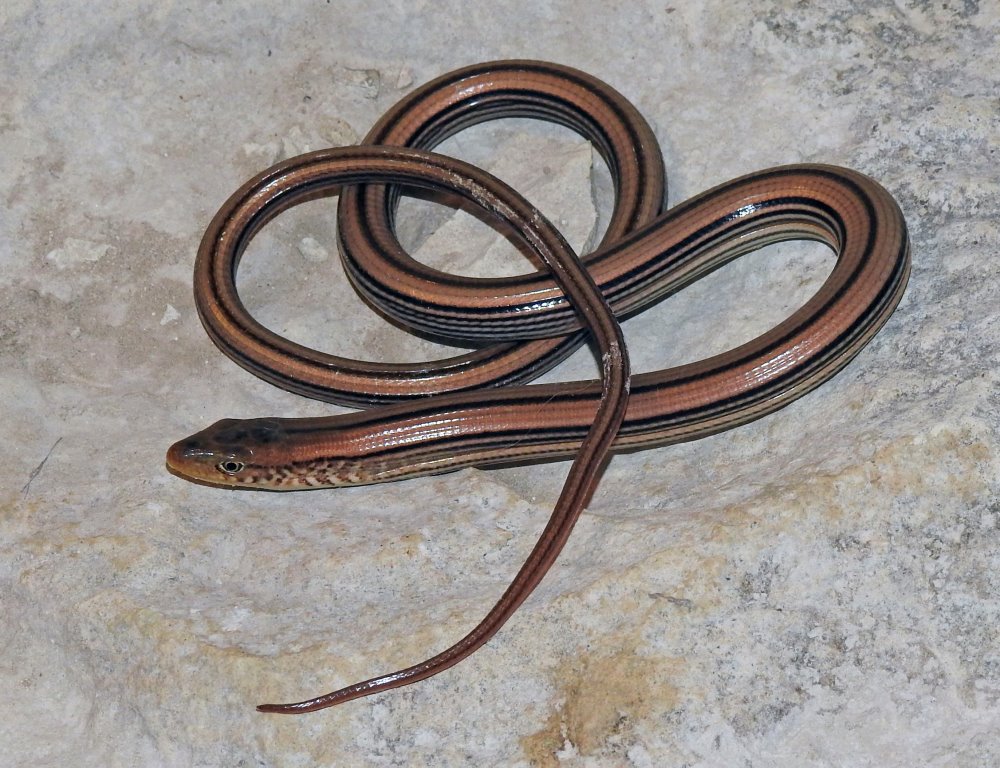
Most of the western slender glass lizards that we found were between 16 and 22 inches in total length.
Last summer Jake and I spent a few days in Kansas looking for western massasaugas and Plains hog-nosed snakes. We succeeded admirably on the rattler (learning in the process that the Kansas examples are as fast as the proverbial greased lightning and very quick to take fright) but failed on the hoggy.
But while we were busily failing on Heterodon we began taking note of the number of western slender glass lizards, Ophisaurus a. attenuatus that we saw. Not only were the anguids present but they were present in numbers, and in huge numbers at that. As the sun was dipping low in the west or, if you prefer, as the earth was spinning rapidly eastward, we would see first one, then another, then 3 or 4 more, all subadults, of this pretty, prominently striped, lizard. By the time we acknowledged failure with the hognose each night we would have seen 10 to 20 glass lizards. While the western slender glass lizard was no stranger to me, at no other place had I seen them in such numbers.
And of at least as much interest as the mere presence of the lizards was the fact that almost all had a full, original tail. Kansas! For me the state itself and remembrances of western slender glass lizards will be forever intertwined.
Continue reading "Western Glass Lizards"
Friday, August 17 2018
Happy Rattlesnake Friday! Today we bring you this serene headshot of a lovely Black-tailed Rattlesnake ( Crotalus molossus), uploaded by kingsnake.com user MartinWhalin1 ! This guy was found in the wild in Arizona and as you can see, he was respected by the herpers and he gave them respect in return. Be sure to tell them you liked it here! As always on Friday, we celebrate all of our venomous reptiles for their contribution to the world.

Upload your own reptile and amphibian photos at gallery.kingsnake.com, and you could see them featured here!
Thursday, August 16 2018
I'm pretty sure photoshop was used on this Ackie in our Herp Photo of the day, uploaded by kingsnake.com user BryanD , but I would prefer to think they are realy taking over outter space! What a cool shot in black and white! Be sure to tell them you liked it here!

Upload your own reptile and amphibian photos photos at gallery.kingsnake.com, and you could see them featured here!
Wednesday, August 15 2018
So very underestimated but how many of you caught a Garter like the one in our Herp Photo of the day, uploaded by kingsnake.com user snakekate for your first field find? Be sure to tell them you liked it here!

Upload your own reptile and amphibian photos at gallery.kingsnake.com, and you could see them featured here!
Tuesday, August 14 2018
Sonoma County has some beautiful Black Speckled Salamanders, just like this one in our Herp Photo of the day, uploaded by kingsnake.com user skyserpent ! Be sure to tell them you liked it here!

Upload your own reptile and amphibian photos at gallery.kingsnake.com, and you could see them featured here!
Monday, August 13 2018
Love the darker phase of this greyband in our Herp Photo of the day, uploaded by kingsnake.com user trevid ! Be sure to tell them you liked it here!

Upload your own reptile and amphibian photos photos at gallery.kingsnake.com, and you could see them featured here!
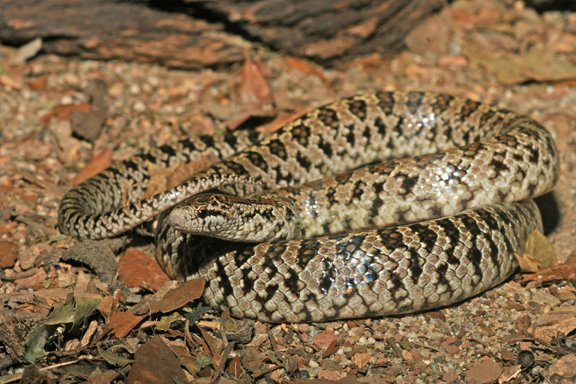
I actually successfully bred this male South Florida mole king with a smaller female--both commercially obtained.
Dratted snake! How many times—how many years—how many pure thoughts—does it take to find a live one? I’ve tried over and over and over again— and then tried again--alone and with Jake. Sum total? Zero alive!
Other friends have found this elusive snake, and acquaintances have found even more. But my total--1, found years ago as road jerky over near Okeechobee City. And that doesn’t count in my book. So, other than a tale of failure, what is the story here?
Well, here it is in shortened format: After Price described this snake (Price, R.M. 1987. Disjunct occurrence of mole snakes in Peninsular Florida, and the description of a new subspecies of Lampropeltis calligaster. Bull. Chicago Herpetol. Soc. 22 (9): 148) the “lamprophiles of which I am not one, began flocking to South Florida (shades of L. alterna!) looking hard for the mole king.
Some succeeded, many (me included) failed. But I did continue to look occasionally, and did so throughout the described range of the subspecies. It was early on that I found the DOR and began to note that even though infrequently seen the snake was collected by others for the pet trade. So, wanting to actually see one in the wild, I began looking a little more frequently. I found garter snakes, water snakes and rat snakes galore, and even an occasional Florida king, but not a single mole king. I got so used to failure that when friends found one, I sulked. Yes, I sulked, and I’m not even fond of kingsnakes of any flavor. But I’m even less fond of perpetual failure.
So I stopped looking, and did so just in time, because the genetic wizards have just elevated it from subspecies status to a full species, and there’s no sense in wasting more time looking for a subspecies when I could be wasting it looking for a full species!
OK, Jake. No more procrastination. It’s time to find one of these durn things. South Florida, here we come!
Continue reading "South Florida Mole King"
Friday, August 10 2018
Happy Rattlesnake Friday! Isn't this a gorgeous Southern Pacific Rattlesnake in our Herp Photo of the day, uploaded by kingsnake.com user Canes05 ! Be sure to tell them you liked it here! As always on Friday, we celebrate all of our venomous reptiles for their contribution to the world.

Upload your own reptile and amphibian photos at gallery.kingsnake.com, and you could see them featured here!
Thursday, August 9 2018
Hopefully the gorgeous blues of this Dendrobates auratus uploaded by kingsnake.com user amazonreptile will brighten your day. Be sure to tell them you liked it here!

Upload your own reptile and amphibian photos photos at gallery.kingsnake.com, and you could see them featured here!
|



